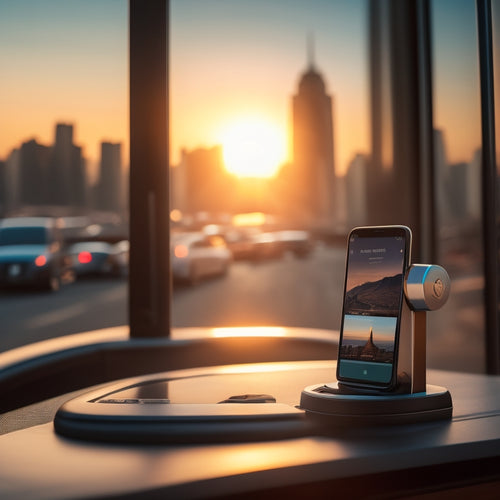
What Makes a Solar Power Bank Portable
Share
When evaluating a solar power bank's portability, you'll want to take into account its compact design, typically around 1-2 inches in thickness, which allows for easy carrying in various environments. Lightweight materials reduce overall weight without sacrificing functionality, making it even more convenient. Additionally, features like foldable solar panels, high-capacity power storage, and multiple USB charging ports further enhance portability. Durability and water-resistance also play a key role, ensuring your power bank can withstand outdoor activities. By examining these factors, you'll gain a better understanding of what makes a solar power bank truly portable, and how you can optimize its performance for your needs.
Key Takeaways
- A compact design with an ideal thickness of 1-2 inches and ergonomic grip enables easy carrying and reduces fatigue during extended use.
- Lightweight materials, such as monocrystalline silicon cells, reduce overall weight without sacrificing functionality and enhance portability.
- A foldable solar panel design simplifies transport and storage, making it ideal for backpackers and outdoor enthusiasts needing space-saving solutions.
- Strategic weight distribution and rounded edges with smooth surfaces further enhance portability and convenience.
- The use of compact and lightweight materials enables effortless carrying in various environments, making solar power banks highly portable.
Compact Design for Easy Carrying
How much space do you have available in your backpack or bag for a solar power bank? When selecting a portable power bank, compact design is vital to guarantee easy carrying.
You need a device that fits snugly in your bag, freeing up space for other essentials. Look for a solar power bank with a slim profile, typically around 1-2 inches thick, to maximize storage capacity. An ergonomic grip is also important, providing a comfortable hold and reducing fatigue during extended trips.
Travel-friendly designs often feature rounded edges and smooth surfaces, making them easy to slip in and out of your bag. Additionally, a compact design allows for effortless carrying, whether you're hiking, camping, or exploring urban environments.
Lightweight Materials Used
Your solar power bank's weight plays a significant role in its portability. A heavy power bank can be cumbersome to carry around, defeating the purpose of its solar-powered convenience. To address this, manufacturers are using lightweight materials to minimize the overall weight of the power bank.
The solar panel itself is a vital component in weight reduction. Different solar cell types have varying weights, with monocrystalline silicon cells being lighter than polycrystalline cells. By choosing the right solar cell type, manufacturers can reduce the weight of the power bank without compromising its energy-harvesting capabilities.
In addition to solar cell selection, weight distribution also plays an essential role in maintaining portability. By strategically placing components within the power bank, manufacturers can guarantee that the weight is evenly distributed, making it easier to carry.
This attention to detail in design and material selection enables you to enjoy the benefits of solar power without the burden of a heavy power bank.
High Capacity Power Storage
When selecting a solar power bank, you're likely looking for one that can store enough energy to keep your devices charged on the go.
The key to achieving this lies in the battery's size and energy density, which directly impact the power bank's overall capacity.
You'll want to take into account how these factors influence the bank's ability to store and supply power efficiently.
Battery Size Matters
A power-hungry device arsenal demands a reliable energy companion, and that's where a high-capacity power bank comes in. You need a portable energy storage solution that can keep up with your devices' power demands.
When it comes to solar power banks, battery size matters. A larger battery capacity means you can charge your devices more times before needing to recharge the power bank itself.
For instance, a 20,000mAh power bank can charge a smartphone up to 5 times, while a 10,000mAh power bank can only charge it twice. With solar technology, you can recharge your power bank on-the-go, making it an ideal solution for outdoor enthusiasts and travelers.
However, a larger battery size doesn't always translate to better power efficiency. Look for power banks with high power efficiency ratings to minimize energy loss during charging and discharging.
Energy Density Counts
High-capacity power storage is key to releasing the full potential of solar power banks. You need a battery that can hold a lot of power relative to its size and weight. This is where energy density comes in – the amount of energy a battery can store per unit of mass. High energy density means more power in a smaller package, making your solar power bank more portable.
| Battery Type | Energy Density (Wh/kg) |
|---|---|
| Lead-Acid | 30-40 |
| Nickel-Cadmium | 40-60 |
| Lithium-Ion | 120-150 |
When choosing a solar power bank, look for high energy density batteries like Lithium-Ion. These batteries provide faster charging speeds and more efficient solar energy storage. This means you can charge your devices quickly and get the most out of your solar panels' energy. A high-capacity power storage system enables you to utilize more solar energy during the day, giving you a reliable power source when you need it most. With high energy density, you can enjoy the freedom to power your devices anywhere, anytime, while keeping your solar power bank compact and portable.
Multiple USB Charging Ports
When you're on-the-go, you need a solar power bank that can keep up with your charging demands.
A multiple USB charging port design enables you to charge multiple devices simultaneously, which is especially useful when you're traveling with a group or have multiple gadgets to keep powered.
You'll want to look for a power bank that offers rapid power delivery and a versatile port configuration to guarantee seamless charging for all your devices.
Simultaneous Device Charging
Your devices are always running out of power at the most inconvenient times, and you're often left juggling between charging one device at a time. A solar power bank with simultaneous device charging capabilities can be a revolutionary tool. This feature allows you to charge multiple devices at the same time, making it an essential aspect of portability.
When evaluating a solar power bank's simultaneous device charging capabilities, consider the following factors:
| Device Compatibility | Number of USB Ports | Charging Efficiency |
|---|---|---|
| Android, iOS, USB-C | 2 | 80% |
| Android, iOS, USB-C, Laptop | 3 | 75% |
| Android, iOS, USB-C, Laptop, Camera | 4 | 70% |
| Android, iOS, USB-C, Laptop, Camera, Power Tools | 5 | 65% |
| Android, iOS, USB-C, Laptop, Camera, Power Tools, Headphones | 6 | 60% |
A good solar power bank should have multiple USB charging ports, ensuring device compatibility and high charging efficiency. With simultaneous device charging, you can power up your devices quickly and efficiently, making it an essential feature for those who need power on-the-go.
Rapid Power Delivery
Rapid power delivery relies on a solar power bank's ability to provide multiple USB charging ports, enabling you to charge several devices at once. This feature is vital when you're on-the-go and need to power up your devices quickly.
With multiple ports, you can charge your smartphone, tablet, and other devices simultaneously, saving you time and increasing your productivity.
Fast charging is another key aspect of rapid power delivery. Look for a solar power bank that supports quick charging protocols like Qualcomm QuickCharge or USB Power Delivery. These technologies can charge your devices up to 3-4 times faster than traditional charging methods.
Additionally, a power bank with high power efficiency is important to minimize energy loss during charging. This guarantees that more power is delivered to your devices, reducing charging times and increasing overall performance.
When selecting a solar power bank, consider the number and type of USB ports, as well as the power output of each port. A power bank with multiple high-power USB ports (e.g., USB-C or QuickCharge 3.0) will provide faster charging speeds and greater power efficiency.
Versatile Port Configuration
Having established the importance of rapid power delivery, it's equally essential to contemplate the versatility of a solar power bank's port configuration. A portable solar power bank with multiple USB charging ports can effectively charge various devices simultaneously, making it an ideal companion for outdoor enthusiasts and professionals alike.
When evaluating a solar power bank's port configuration, consider the number and type of ports available. Look for devices with multiple USB-A ports, as well as USB-C and DC outlets, to guarantee compatibility with a wide range of devices. This versatility enables you to charge laptops, smartphones, and cameras simultaneously, streamlining your workflow and minimizing downtime.
Solar technology has advanced considerably, and modern solar power banks boast impressive power efficiency. When paired with a versatile port configuration, these devices can deliver reliable and efficient power in various environments.
Durable and Water-Resistant Build
Most solar power banks boast a durable and water-resistant build, designed to withstand the rigors of outdoor use. You need a power bank that can keep up with your active lifestyle, whether that's camping, hiking, or working in harsh environments. A durable build guarantees your power bank can withstand accidental drops and bumps, while water-resistance protects it from rain, snow, or other environmental factors.
| Feature | Description | Benefit |
|---|---|---|
| IP67 Rating | Protects against dust and water ingress | Peace of mind in harsh environments |
| Impact-Resistant Materials | Withstands drops and bumps | Reduces risk of damage |
| Waterproof Coating | Prevents water penetration | Guarantees continued operation in wet conditions |
When choosing a solar power bank, look for features like IP67 ratings, impact-resistant materials, and waterproof coatings. These features guarantee your power bank can withstand the elements and keep your devices charged on the go. By prioritizing durability and water-resistance, you can have confidence in your power bank's ability to perform, even in the most challenging conditions.
Foldable Solar Panel Design
In tandem with its durable build, a solar power bank's foldable solar panel design is a groundbreaking development for portability. This innovative design allows you to utilize the sun's energy without the bulk of traditional solar panels. When not in use, the panels can be easily folded up, reducing the overall size and weight of the power bank.
The benefits of a foldable solar panel design are numerous:
-
Increased solar efficiency: By allowing you to easily adjust the angle and position of the panels, you can maximize energy absorption and reduce energy loss.
-
User convenience: The compact design makes it easy to transport and store the power bank, ensuring you have a reliable source of energy wherever you go.
-
Reduced storage space: The foldable design takes up less space when not in use, making it ideal for backpackers, campers, and outdoor enthusiasts.
With a foldable solar panel design, you can enjoy the freedom to navigate without worrying about running out of power. This feature is a significant breakthrough for anyone who needs a reliable and portable source of energy.
Efficient Energy Conversion Rate
Frequently, solar power banks with high-efficiency energy conversion rates are the difference between a reliable source of energy and a useless device.
You need a solar power bank that can efficiently convert sunlight into electrical energy to charge your devices on the go. A high-efficiency energy conversion rate guarantees that you can quickly recharge your devices, even in low-light conditions.
Look for solar power banks with high solar panel efficiency, typically above 20%, to maximize energy conversion. This will greatly impact your charging speed, allowing you to replenish your devices' batteries faster.
A high-efficiency energy conversion rate also enables your solar power bank to store excess energy for later use, reducing downtime and increasing overall performance.
When choosing a solar power bank, prioritize energy conversion efficiency to guarantee you have a reliable and efficient source of power whenever and wherever you need it.
Versatile Mounting Options
A solar power bank with versatile mounting options is crucial for convenient and flexible energy harvesting. You want to be able to place your power bank in a way that maximizes energy absorption, regardless of your surroundings. A portable solar power bank with adjustable mounting options guarantees you can do just that.
Here are three key features to look for:
-
Multiple attachment points: A power bank with multiple attachment points, such as carabiners, hooks, or suction cups, allows you to securely fasten it to various surfaces, like backpacks, tents, or vehicle roofs.
-
Adjustable angles: A power bank with adjustable angles enables you to fine-tune the panel's position to optimize energy harvesting, even in changing sunlight conditions.
-
Mounting stability: A sturdy and stable mounting system guarantees your power bank remains in place, even in windy or rough conditions, providing uninterrupted energy harvesting.
With these features, you can confidently place your solar power bank in a position that maximizes energy absorption, assuring you have a reliable source of power on-the-go.
Frequently Asked Questions
Can I Use a Solar Power Bank to Charge My Laptop?
You can use a solar power bank to charge your laptop if it meets the charging compatibility requirements, but consider the energy efficiency, as it may take longer to fully charge, and check the power bank's capacity to verify it can handle your laptop's power needs.
How Long Does It Take to Fully Charge a Solar Power Bank?
As you bask in the sun's warm rays, your solar power bank drinks in its energy, but how long until it's fully quenched? Charging efficiency and solar panel capacity dictate the timeline, with a 20,000mAh bank taking around 10-15 hours to fully charge under ideal conditions.
Are Solar Power Banks Affected by Cloudy or Shady Conditions?
When you're relying on a solar power bank, you'll notice cloudy or shady conditions reduce its solar efficiency, slowing down the charging speed; but, you can still capture some energy, albeit at a lower rate, making it essential to plan your charging sessions accordingly.
Can I Use a Solar Power Bank in Extremely Cold Temperatures?
You'll find that most solar power banks can operate in temperatures as low as -20°C, but their solar efficiency drops considerably. Check the manufacturer's temperature performance specs to guarantee maximum energy harvesting in extremely cold conditions.
Do Solar Power Banks Have Built-In Surge Protection?
You'll be glad to know that most solar power banks have built-in surge protection, ensuring safe and efficient power management, so you don't have to worry about overcharging or electrical shocks when recharging your devices on-the-go.
Related Posts
-

Why You Need a Phone Mount for Navigation
When you're on the road, a reliable phone mount is not just a convenience, it's a safety necessity that helps you mai...
-

Safety First: Why Seniors Need Advanced Vehicle Features
As you get behind the wheel, you're likely unaware that seniors are 16% more likely to be involved in a fatal car cra...
-

What Is the Cost to Put in Solar Panels
You're likely considering solar panels for your home, and the most significant factor in your decision is the upfront...


